How to Create a Schedule to Backup User Files[Step-by-Step Guide]
User Files are folders that are used to store a particular user account on your computer. Scheduling backup of these user files can create an extra layer of protection for your data in case something happens to your computer. Scheduled automatic backups also take the hassle out of manual operations. This article covers three available ways to create a schedule to backup user files. Read it and find the method that suits you.
The Importance of Backing Up User Files
User files are folders used to store particular user accounts on your computer. They include all the specific user's settings, preferences, and application data. In other words, they are everything you need to create a profile on a computer.
The user files on Windows are usually stored in the C:\Users\(username) folder, which is vulnerable to computer failures. If a virus attacks your computer or something goes wrong, you will need to reinstall Windows, and all user files will be deleted. Therefore, it is essential to back up user files. Backups for your user files can create an extra layer of protection for your data.
Create a scheduled backup for user files has the following benefits:
- Scheduled automatic backups take the hassle out of manual operations.
- Save time and energy by having your computer create backups for you automatically.
- Scheduled backups are safer because no one can view the data.
A Thorough Comparison of Three User Files Scheule Backup Methods
Windows provides two built-in backup features: Backup and Restore and File History. They both allow you to create a scheduling backup for user files. However, these two tools are different in some ways and have their limitations. To create a user files schedule backup more flexibly, we recommend you try a third-party tool called Qiling Backup.
The following table is a comprehensive comparison of the three utilities:
| Comparison | Qiling Backup | Backup and Restore | File History |
|---|---|---|---|
| Compatible system | Windows 7/8/10/11 | Windows 7/10/11 | Windows 8/10/11 |
| Backup source |
|
|
|
| Backup destination |
|
|
|
| Backup type |
|
|
|
| Step-by-step guide | Create a Schedule to Backup User Files with Qiling Backup | Create a Schedule to Backup User Files with Backup and Restore | Create a Schedule to Backup User Files with File History |
Here are some other functions for Qiling Backup:
- Schedule backup: automatically create full/incremental/differential backup at a scheduled time.
- Backup to image: create an image file of the specified partitions or disks image and save it to a safe location.
- Clone disk or partition: upgrade system disk, migrate OS to SSD or copy data from one disk to another without reinstalling Windows.
- Create rescue media: create a bootable disc of Qiling Backup to restore the system or data when the computer fails to boot.
- WinPE Bootable Disk: create a bootable WinPE environment on USB or CD/DVD, and use it to restore system or data when the computer fails to boot.
- Security Zone Backup: save backup files to a security zone that is an inaccessible partition, so malware or ransomware cannot affect it.
- 250 GB of free Cloud backup: Qiling offers 250 GB of free Cloud storage. You can put your backup files in the cloud, which is more secure than backing them up locally.
Step-by-Step Guide to Create a User Files Schedule Backup
Method 1. Create a Schedule to Backup User Files with Qiling Backup
Applied system: Windows 7/8/10/11
Step 1. For the first time you use Qiling Backup to back up files, click File backup on the home screen, where you can select pictures, videos, documents and all other types of files to back up.

Step 2. Follow the paths to locate the files, folders or directories you want to back up, select them all.
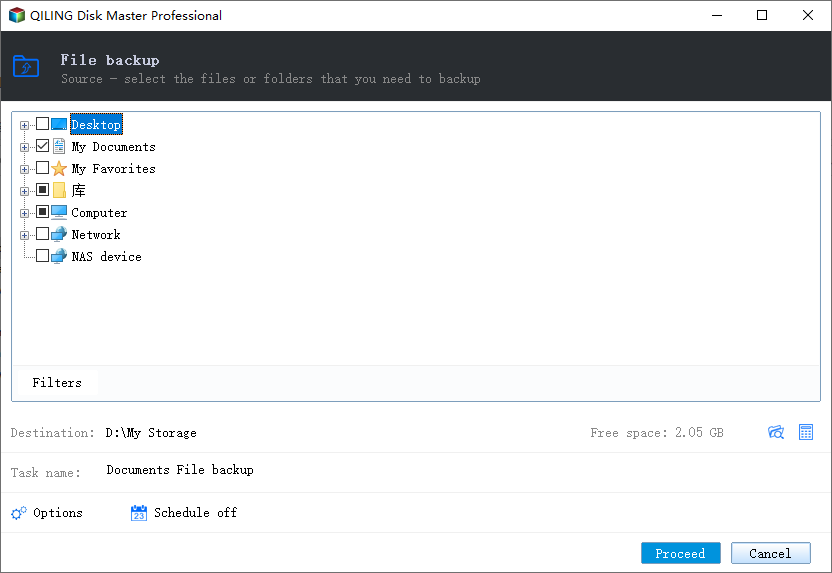
Step 3. Now you need to select a backup location to save and retain the backup.
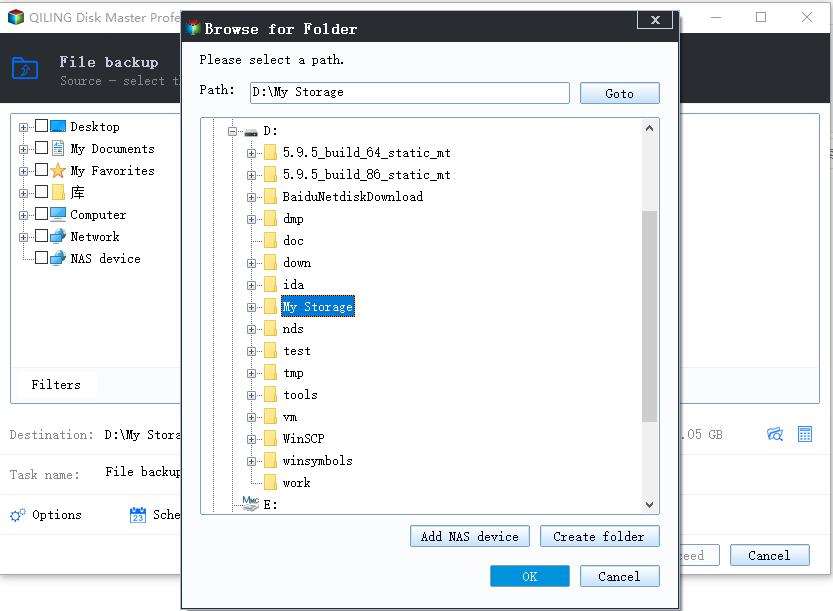
Step 4. Qiling Backup allows users to save the backup files to every device that is handy for you, like a local hard drive, external USB drive, SD card, network drive, or a NAS drive, plus a cloud drive of the Qiling brand. We personally recommend users to choose the cloud drive prior to a physical drive to save important backups due to the greater accessibility, flexibility and safety.
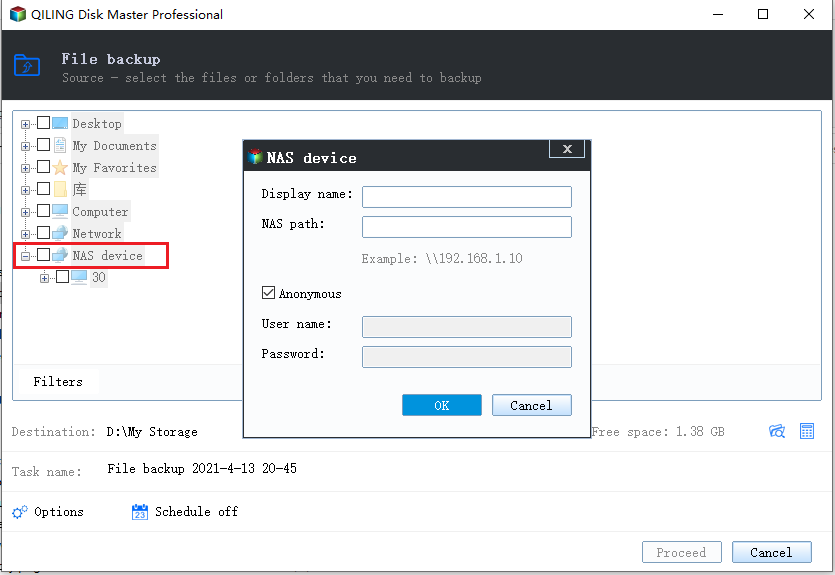
Step 5. If you're interested in an automatic and intelligent backup schedule for the next file backup task, go on with the "Options" setting. There you can encrypt a confidential file backup, compress the backup image size, or customize a backup scheme to tell the software in what time to start the next backup.
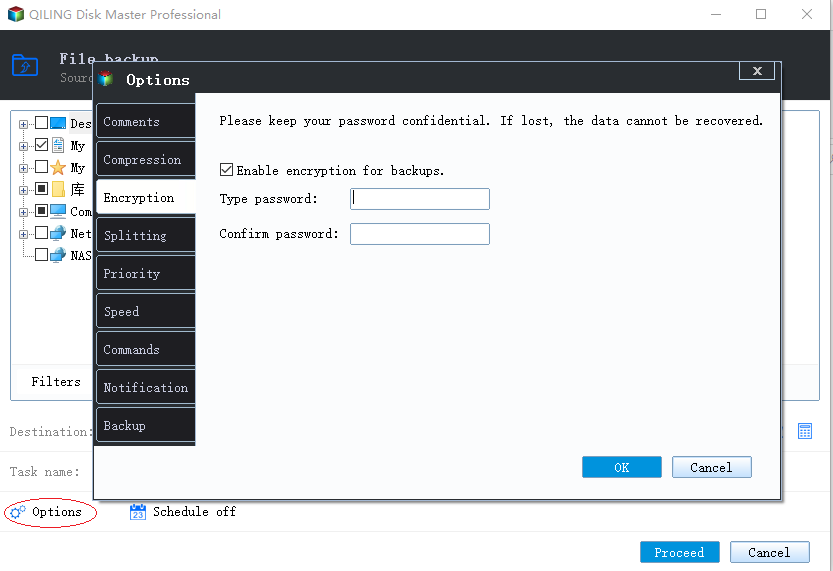
Customize an advanced and automatic backup task here:
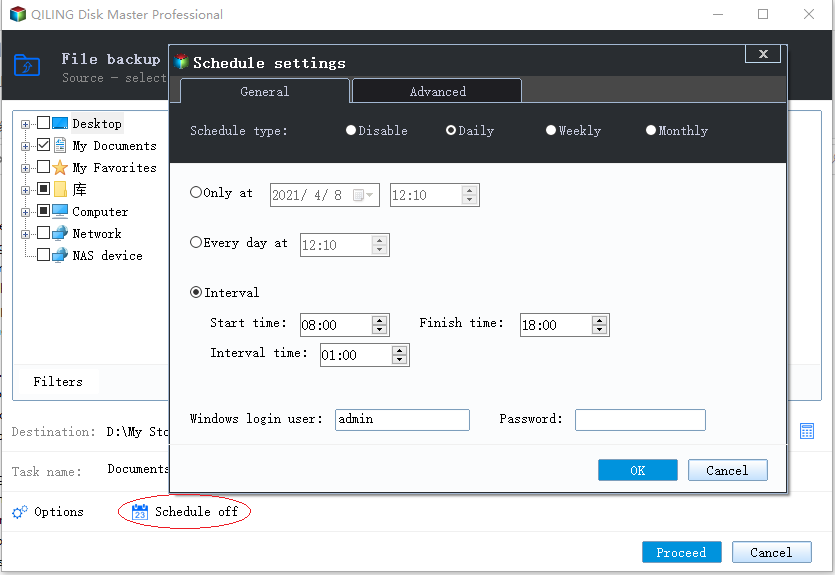
Step 6. Click "Proceed" to start the file backup process. Your completed backup files are visible on the left area in a card style.
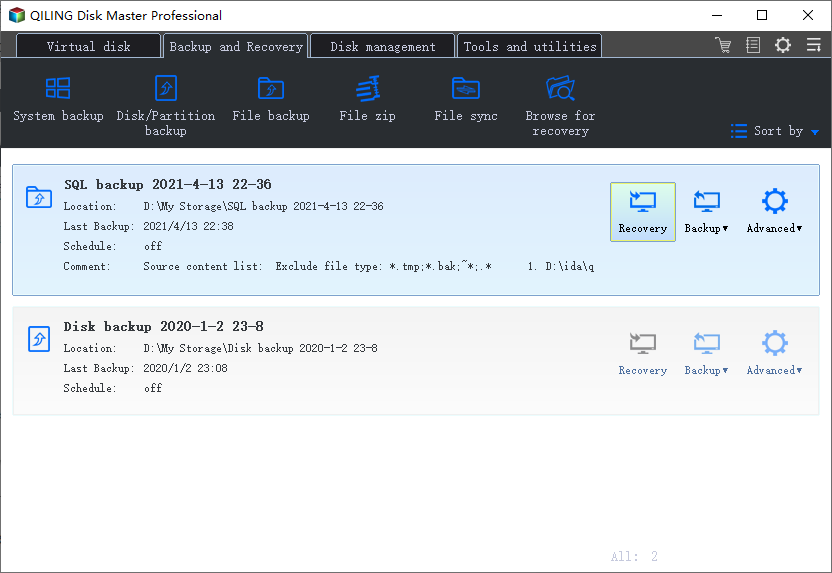
Method 2. Create a Schedule to Backup User Files with Backup and Restore
Applied system: Windows 7/10/11
Step 1. Click on the Start menu and enter "backup". Select Backup and Restore from the list. Or go to the Control Panel to find Backup and Restore.
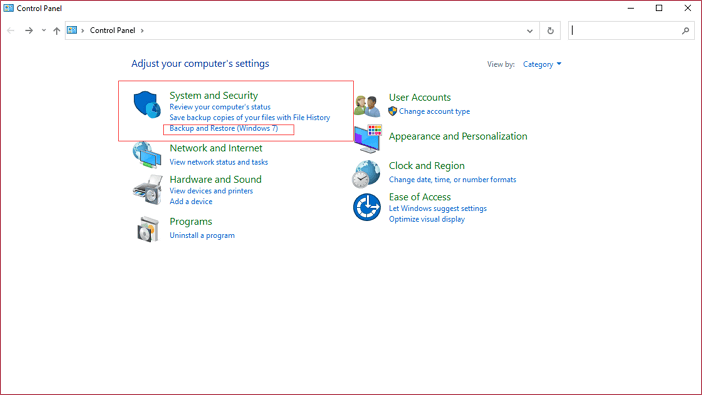
Step 2. Click "Set up backup".
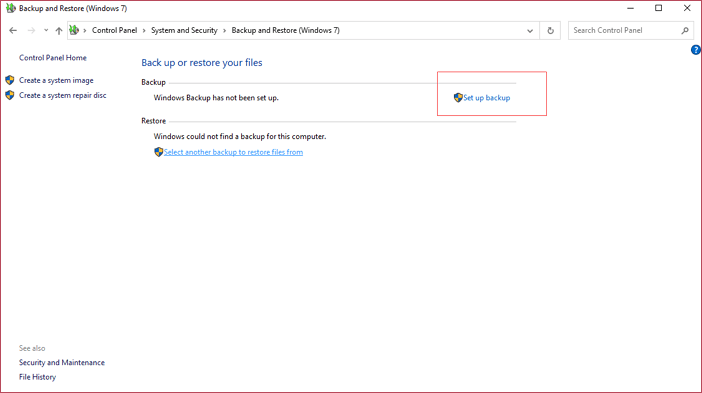
Step 3. Select a destination place you want to save your backup, and tap Next.
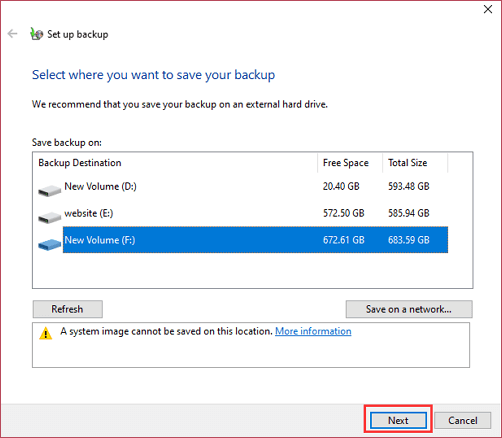
Step 4. Check the "Let me choose" option, then click Next.
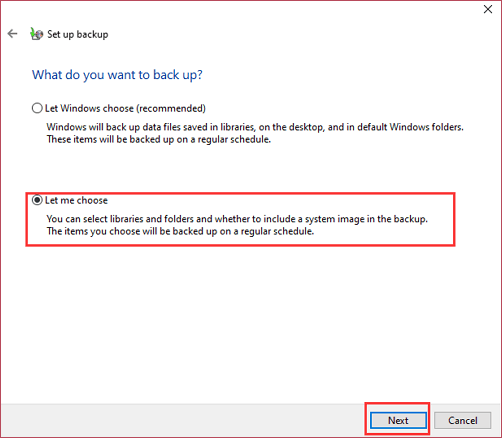
Step 5. Find and choose the user files you want to create backup, and click Next.
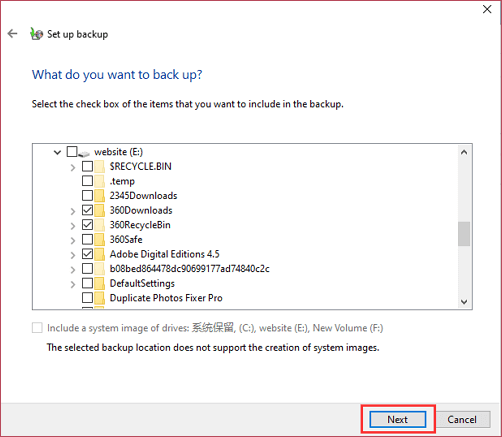
Step 6. Click "Change schedule" to customize your schedule backup plan based on your needs.
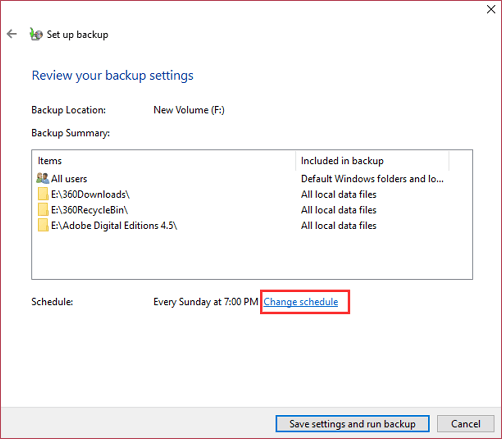
Here you are supposed to set how often, what days, and what time to back up.
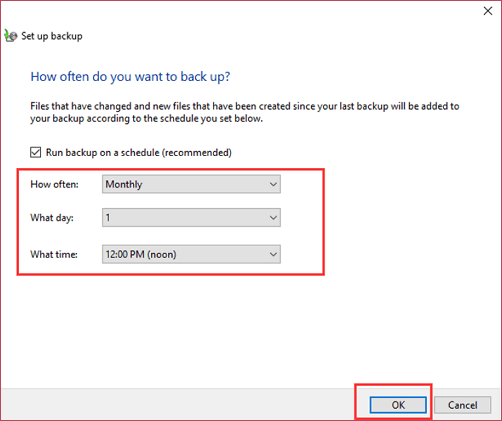
Method 3. Create a Schedule to Backup User Files with File History
Applied system: Windows 8/10/11
- Notice:
- Using File History to back up user filers requires an external hard drive, make sure a hard drive is connected to your computer while backing up. The frequency of using this method for scheduled backups is less than the previous two.
Step 1. Find the File History by following the path: Setting > Storage > View backup options.
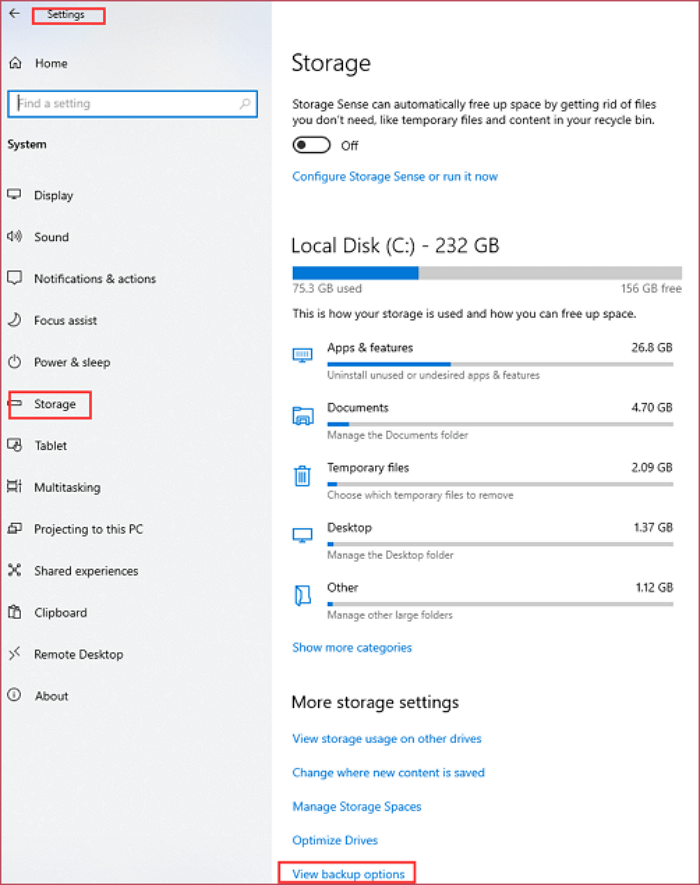
Step 2. Click the "Add a drive" button to choose a place to save your backup. When selected, you will see the switch bar is on.
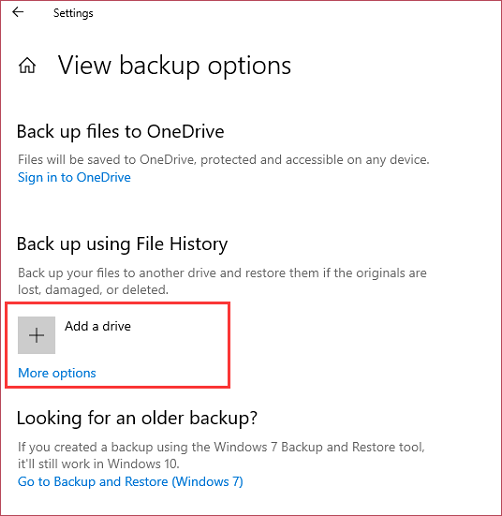
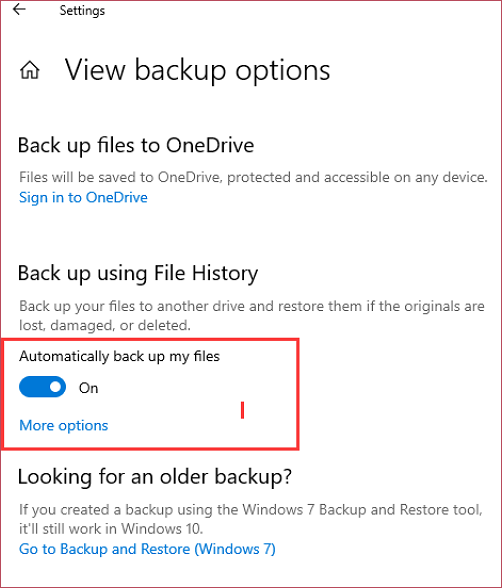
Step 3. To choose the user files you want to backup, click the "More options" button and click "Add a folder."
- Tip
- The default backup frequency is every hour, and the lasted time is forever. You can customize them as needed.
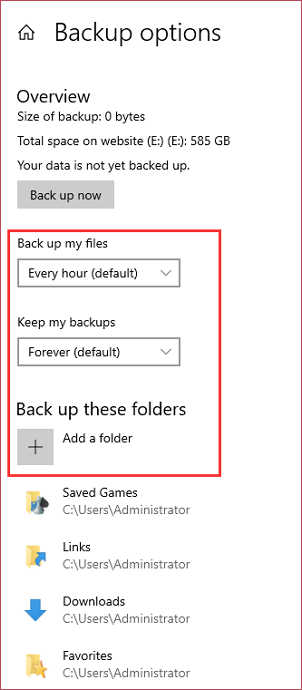
Wrapping Up
Through this article, we believe that you can successfully create a schedule to backup user files using Qiling Backup, Backup and Restore, and File History. We recommend you use Qiling Backup because it is more flexible and comprehensive. Apart from backup, it also supports clone, creating rescue media, creating a bootable WinPE environment, etc.
If you have any other questions or suggestions, please feel free to contact us.
Create Schedule Backup for User Files FAQ
1. How do I use Task Scheduler to backup files
Create a new task in Task Scheduler and name it. Then, select the frequency that you want the task to run at. After that, create an action to backup files with copy command line or Xcopy. Finally, create another action to delete the original files.
2. What is the best backup schedule?
There is no one-size-fits-all answer to this question. It depends on your needs and usage. But we generally recommend the following backup schedule:
- Daily backup for files that are frequently changed
- Weekly backup for files that are less frequently changed
- Monthly backup for files that are rarely changed
3. Does Windows 10 have an automatic backup?
Yes. Windows 10 has two built-in backup tools, Backup and Restore and File History. You can use them to create a schedule to backup files automatically. Please refer to the above step-by-step guide for more details.
4. What is the 3-2-1 rule for backups?
The 3-2-1 rule is a general guideline for creating backups. It states that you should have at least three copies of your data stored on two different media, with one copy kept off-site. For example, you can have one copy of your data on your computer's hard drive, another on an external hard drive, and a third copy in the cloud. If one copy is lost or corrupted, you will still have two other copies to fall back on.
Related Articles
- [Tutorial] How to Backup Excel File Automatically in 2 Tested Approaches
- Backup HDD with Bad Sectors [Detailed Guides]
- Backup Data to Tape with Tape Backup Software
- Download Crucial Data Transfer Software to Migrate SSD Data and OS